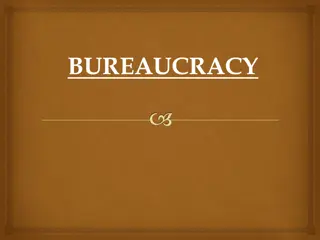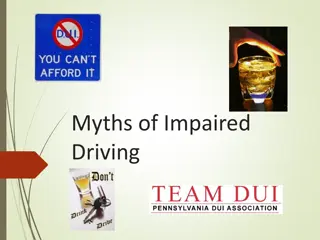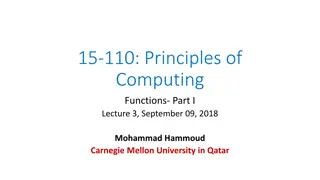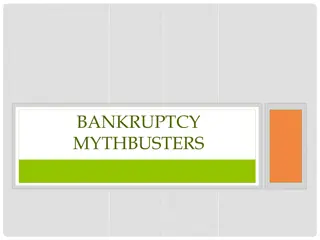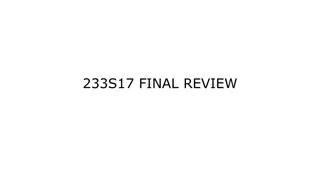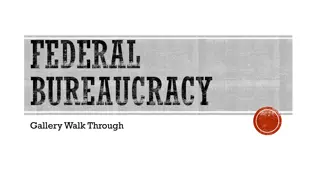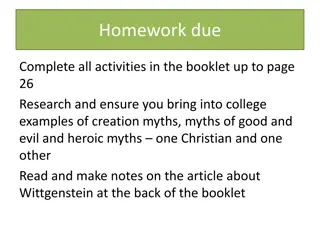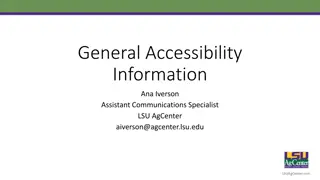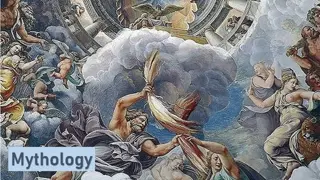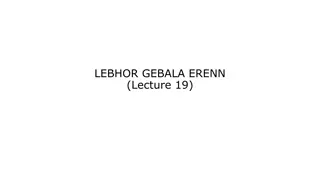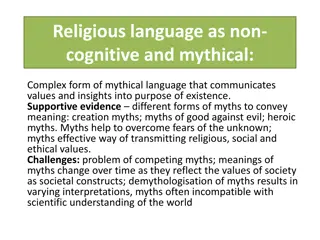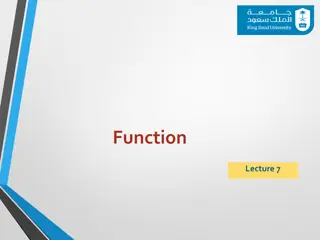Bureaucracy: Origins, Functions, and Myths
Explore the concept of bureaucracy, tracing its origins and elements according to Max Weber's analysis. Discover the evolution from patronage to the merit-based system and debunk common bureaucratic myths prevalent in society. Gain insights into the role of civil servants and the intricate workings of bureaucratic organizations over time.
Download Presentation

Please find below an Image/Link to download the presentation.
The content on the website is provided AS IS for your information and personal use only. It may not be sold, licensed, or shared on other websites without obtaining consent from the author.If you encounter any issues during the download, it is possible that the publisher has removed the file from their server.
You are allowed to download the files provided on this website for personal or commercial use, subject to the condition that they are used lawfully. All files are the property of their respective owners.
The content on the website is provided AS IS for your information and personal use only. It may not be sold, licensed, or shared on other websites without obtaining consent from the author.
E N D
Presentation Transcript
Bureaucracy Large, complex organization of appointed, not elected, officials. Includes all of the agencies, people, and procedures needed to operate the government bureau French for small desks, referring to the king s traveling business men who set up small desks in town squares Bureaucracy = government of small desks or rule by desks
Max Weber Famous early 20thcentury German economist Bureaucracy well organized, complex machine that is a rational way for society to organize its business Weber identified five common characteristics of a successful bureaucracy
Webers Analysis Hierarchical authority structure chain of command, authority flows from top down Task specialization individuals have unique jobs, become experts in their area Extensive rules clear policies allow similar cases to be handled in similar ways Merit principle hiring and promotion based on ability, not favoritism Impersonality clients are treated impartially
Bureaucratic Myths Americans generally dislike bureaucrats. Americans are generally satisfied with their interactions with bureaucracies. The (federal) government is getting bigger every year! Most growth is state and local Bureaucracies are ineffective and inefficient! Government bureaucracies are no more or less efficient than private bureaucracies.
Who are the Civil Servants? The bureaucracy is more representative of the demographics of our population than Congress, the Courts, or presidential appointees in the executive branch. The diversity in bureaucratic jobs mirrors the diversity in private sector jobs. Until ~ 100 years ago, jobs were awarded through the patronage (spoils) system. a hiring and promotion system for political reasons, based on knowing the right people.
Way Back When Patronage - Rewarding supporters with jobs Spoils system created by Andrew Jackson, each President turned over the bureaucracy Pendleton Act (1883) - Created in response to criticism of patronage, more jobs will be selected based on merit
How are Civil Servants hired? Pendleton Civil Service Act of 1883 created a federal civil service Civil Service Hiring and promotion based on merit and nonpartisan government service. Merit principle - produces administration by people with talent and skill based on exam scores and job performance (promotion ratings). Nonpartisan civil service - government workers insulated from the risk of being fired when a new party comes to power.
How are the Civil Servants hired? Part Deux GS (General Schedule) rating ranges from GS 1 to GS 18, by which positions and salaries can be keyed to rating and experience. Senior Executive Service 9,000 federal government managers that provide leadership at the top of the civil service system. High salaries, can be moved around based on need Office of Personnel Management (OPM) is in charge of hiring for most agencies of the federal government. For each position that is open, the OPM will send three names to the agency (known as the rule of three).
Job Security After a probationary period, civil servants are protected (very difficult to fire) An employee can appeal his or her dismissal, which can consume weeks, months, or even years. (The right of appeal must be exhausted before one s paycheck stops.) Ensuring a nonpartisan civil service requires that workers have protection from dismissals that are politically motivated. Protecting all workers against political firings may also protect a few from dismissal for good cause. It is much easier to dismiss a cabinet member.
Political Appointees Every incoming president launches a nationwide talent search to almost 3,000 positions. Plum Book A listing of the top federal jobs available for direct presidential appointment, often with Senate confirmation. 500 top policymaking posts (mostly cabinet secretaries, undersecretaries, assistant secretaries, and bureau chiefs) and 2,500 lesser positions.
Political Appointees (II) Presidents look for individuals who combine executive talent, political skills, and policy views similar to those of the president. NOT civil service or merit positions Incoming presidents try to ensure diversity and balance in terms of gender, ethnicity, region, and party interests. Some positions especially ambassadorships go to large campaign contributors. Most will be political appointees, in-and-outers, who stay for a while and then leave; they soon learn that senior civil servants know more, have been there longer, and will outlast them.
What do bureaucrats do? Discretionary action have the power to execute laws and policies passed down by the president or congress. Implementation develop procedures and rules for reaching the goal of a new policy Regulation check private business activity Munn v. Illinois (1877) SCOTUS upheld that government had the right to regulate business rates and services
Sheeple Administrative routine - bureaucrats follow standard operating procedures (SOPs) to help them make numerous everyday decisions. SOPs bring uniformity to complex organizations. Justice is better served if rules are applied uniformly. Uniformity also makes personnel interchangeable. Routines are essential to bureaucracy they also become frustrating to citizens, who term them red tape when they do not appear to appropriately address a situation, and may become obstacles to action.
When they arent Sheeple Administrators dispositions - bureaucrats operate within strict routines but often have considerable discretion to behave independently. Administrative discretion - the authority of policy administrators to select among various responses to a given problem. Discretion is greatest when rules do not fit a case; but even in agencies with elaborate rules and regulations especially when more than one rule fits there is still room for discretion. street-level bureaucrats - bureaucrats who are in constant contact with the public and have considerable discretion (including police officers, welfare workers, and lower court judges). discretion depends on their dispositions about the policies and rules they administer (bureaucrats may be indifferent to the implementation of most policies, but some may conflict with their policy views or personal or organizational interests). The exercise of discretion is hard to control: it is not easy to fire bureaucrats in the Civil Service, and removing appointed officials may be politically embarrassing to the president.
Cabinet Departments Each department manages specific policy areas, and each has its own budget and its own staff. Each department has a mission and is organized differently. Bureaus (sometimes they are called administration, service, or office) divide the work into more specialized areas.
Implementation Policy implementation occurs when the bureaucracy carries out decisions of Congress, the president, and even the courts. Public policies are rarely self-executing: bureaucrats translate legislative policy goals into programs. Congress typically announces the goals of a policy in broad terms, sets up an administrative apparatus, and leaves the bureaucracy the task of working out the details of the program.
3 Steps of Policy Implementation Creation of a new agency or assignment of responsibility to an existing one Coordination of resources and personnel to achieve the intended goals. Translation of policy goals into operational rules of thumb and development of guidelines
Privatization Private Contractors provide services without expanding the permanent bureaucracy. Private Contractors provide specialized skills that the government workers may lack. Competition in the private sector will (theoretically) result in better service at lower costs (there is no evidence to prove this). Contracting leads to less public scrutiny, as government programs are hidden behind closed corporate doors.
Policy Failure Faulty program design - a policy or program may be defective in its basic theoretical conception Lack of clarity - bureaucracies are often asked to implement unclear laws Lack of resources lack of staff, necessary training, funding, supplies, and equipment (sometimes authority) Administrative Routine - Standard Operating Procedures (aka Red Tape) do not always neatly apply to a situation Administrative Discretion - the authority of bureaucrats to choose from variety of responses to a given problem. Fragmentation - responsibility for a policy is sometimes dispersed among several units within the bureaucracy.
A Great Success!! The Voting Rights Act of 1965 was successfully implemented because Its goal was clear: to register African Americans to vote in southern counties where their voting rights had been denied for years. Congress outlawed literacy tests and other tests previously used to discriminate against African-American registrants. The act singled out six states in the Deep South in which the number of African-American registered voters was minuscule.
Voting Rights Act of 1965 Its implementation was straightforward (sending out people to register them). The Justice Department was ordered to send federal registrars to each county in those states to register qualified voters. Implementation of this act helped bring the vote to some 300,000 African Americans in less than a year.
Voting Rights Act of 1965 Authority of the implementers was clear They had the support of the attorney general and even U.S. marshals. Authority concentrated in the Justice Department disposed to implementing the law vigorously.
Independent Regulatory Commissions Responsible for making (legislative) and enforcing (executive) rules to protect the public interest in some sector of the economy and for judging (judicial) disputes over these rules. Each is governed by a small commission, appointed by the president for fixed terms of office and confirmed by the Senate; regulatory commission members cannot be fired by the president. Critics claim that the close connection between the regulators and the industries they regulate has meant that the agencies have become the captives of industry.
Examples ICC (Interstate Commission), FRB (Federal Reserve Board), NLRB (National Labor Relations Board), FCC (Federal Communications Commission), FTC (Federal Trade Commission), SEC (Securities and Exchange Commission) AND NRC (Nuclear Regulatory Commission)
Regulation Use of governmental authority to control or change some practice in the private sector. Congress gives bureaucrats broad mandates to regulate activities (interest rates, the location of nuclear power plants, & food additives) Most all bureaucratic agencies not only the ones called independent regulatory agencies are in the regulatory business Most government regulation is clearly in the public interest (example, the U.S.D.A. regulates the quality of meat products)
3 Elements of Regulation A grant of power (authority) and set of directions from Congress. A set of rules and guidelines by the regulatory agency itself. Some means of enforcing compliance with congressional goals and agency regulations.
Origins Munn v. Illinois (1877) Upheld the right of government to regulate the business operations of a firm. The case involved the right of the state of Illinois to regulate the charges and services of a Chicago warehouse. Interstate Commerce Commission (1887) was the 1stregulatory agency, created to regulate the railroads, their prices, and their services to farmers.
How to Regulate Regulatory Agencies have to develop a set of rules (often called guidelines) guidelines are developed in consultation with (and sometimes with the agreement of) the people or industries being regulated. The agency must then apply and enforce its rules and guidelines, either in court or through its own administrative procedures.
2 Systems Command-and-control policy: The government tells business how to reach certain goals Checks that these commands are followed Punishes offenders Incentive system Market like strategies such as rewards are used to manage public policy.
When to Regulate? Sometimes it waits for complaints to come to it (as the Equal Employment Opportunity Commission does). Sometimes it sends inspectors into the field (as the Occupational Safety and Health Administration does). Sometimes it requires applicants for a permit or license to demonstrate performance consistent with congressional goals and agency rules (as the Federal Communications Commission does).
Deregulation The lifting of government restrictions on business, industry, and professional activities. The idea behind deregulation is that the number and complexity of regulatory policies have made regulation too complex and burdensome. Critics of regulation say: It raises prices. It hurts America s competitive position abroad. It does not always work well.
Deregulation Critics Public would not be protected against severe environmental damage and power shortages, failures in the savings and loan industry, and dangerous fluctuations in the real estate market. Critics of deregulation point to severe environmental damage resulting from lax enforcement of environmental protection standards during the Reagan administration. Many observers attribute at least a substantial portion of the blame for the enormously expensive bailout of the savings and loan industry to the deregulation of it in the 1980s.
Government Corporations They provide a service that could be provided by private sector They typically charge for their services, though often at cheaper rates than the consumer would pay a private sector producer. You can not buy stock and you can not collect dividends like with private corporations.
Examples Tennessee Valley Authority (TVA) Amtrak Federal Deposit Insurance Corporation (FDIC) U.S. Postal Service (the largest of the government corporations)
Independent Executive Agencies They are not part of the cabinet departments, independent regulatory commissions, or government corporations They generally do not have regulatory functions They usually perform specialized functions Their administrators are typically appointed by the president and serve at his pleasure (can be fired)
Examples Social Security Administration (SSA) General Services Administration (GSA) National Science Foundation (NSF) National Aeronautics and Space Administration (NASA).
Accountability Bureaucracy is constrained and controlled by the US government Hatch Act (1939) Government employees can not participate in partisan politics while on duty (elections, campaigns, fund raisers, etc.) Softened in recent decades, 1stAmendment issues
Presidential Control Appoint the head of an agency: putting their people in charge is one good way for presidents to influence agency policy (also able to fire in most cases) Issue orders: executive orders to agencies; or presidential aides can pass the word that the president was wondering if . . . Control of an agency s budget: each agency has some influence with Congress, and it is Congress that appropriates funds Reorganize an agency: sometimes not possible due to an entrenched bureaucracy, backed by elements in Congress and strong constituent groups.
Congressional Control Influence the appointment of agency heads: even when senatorial approval of a presidential appointment is not required, members of Congress may be influential. Control of an agency s budget: the congressional power of the purse is a powerful weapon for controlling bureaucratic behavior. Hold hearings: committees and subcommittees can hold periodic hearings as part of their oversight job. Rewrite the legislation or make it more detailed: Congress can write new or more detailed legislation to limit bureaucratic discretion and make its instructions clearer.
Iron Triangles CONGRESS INTEREST GROUPS BUREAUCRACY Iron Triangle - three-way alliance among legislators, bureaucrats, and interest groups to make or preserve policies that benefit their respective interests
How it works? Everyone in the triangle has a similar interest Legislatorsget funding from interest groups and make laws reality with the help of the bureaucracy Interest groups provide valued information to bureaucrats and money to legislators Bureau chiefs implement legislator policy and interest group goals.
Example Why is tobacco not illegal? House and Senate representatives, sympathetic to tobacco, receive campaign funds and support from tobacco by interest groups, and the representatives make sure that tobacco farmers are defended through legislation. DOA agency executes the legislation while relying on the Congressional budget. The interest groups provide the DOA with valuable information to effectively execute laws. -COMMON INTEREST Keep tobacco alive = keep their jobs alive
Why are they iron? Strong bond can t be easily broken by President or Congress or anyone There is an immense amount of money and power that no one wants to surrender Referred to as sub governments, all the real decisions are made among these 3 groups
Issue Network Iron triangles are susceptible to hyper-pluralism there are Interest Groups from opposite sides of an issue who compete and stymie policy making Issue Network complex group (includes media, academics, policy experts, congressional staff, and interest groups) that debates an issue and slows policy-making The president often fills agency positions with people from an issue network who support the president s own views



